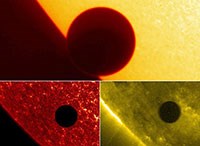|
Sunday, May 20, 2012: ... A late-afternoon Annular Eclipse of the Sun. . . NASA scientists, amateur astronomers, and the National Park Service will team up to share their telescopes and knowledge with park visitors... followed by an evening South Rim Star Party. 
Dr. Tyler Nordgren, Univ. of Redlands Grand Canyon National Park lies in the path of a rare annular eclipse of the sun, late in the afternoon of May 20, 2012.
o 5:28 p.m.-partial eclipse begins o 6:34 p.m. - annular eclipse begins o 6:39 p.m. - annular eclipse ends o 7:32 p.m. - sun sets while still partially eclipsed
Before the eclipse, at 11:00 a.m. - 1:00 p.m. and 3:00 p.m., (South Rim only): NASA scientists will offer a free program about eclipses and the latest NASA research relating to the sun and moon. Seating is limited: free tickets will be available on a first-come, first-served basis starting at 8:00 a.m. on May 20 at the Grand Canyon Visitor Center. 
Nancy K. Varga To view the eclipse with National Park Service rangers: Check posted signs upon arrival in the park for location of assisted viewing activities. On the South Rim, amateur astronomers and NASA scientists will share their telescopes with the public both during the eclipse and again after dark for a one-night "Star Party.On both rims, at posted locations rangers will use pinhole cameras and/or "solar projection" to show additional images of the eclipsed sun, and will have a limited number of eclipse glasses to share. Questions ? Contact us: 
To view the eclipse on your own: You can watch the eclipse unfold from any Grand Canyon viewpoint that offers a clear view of the western horizon (since the annular portion of the eclipse occurs within an hour of sunset). Any of the more famous sunset locations will do.

FRED ESPENAK, NASA'S GSFC Click here to view a diagram showing the parts of the Earth
|
Last updated: March 1, 2021


